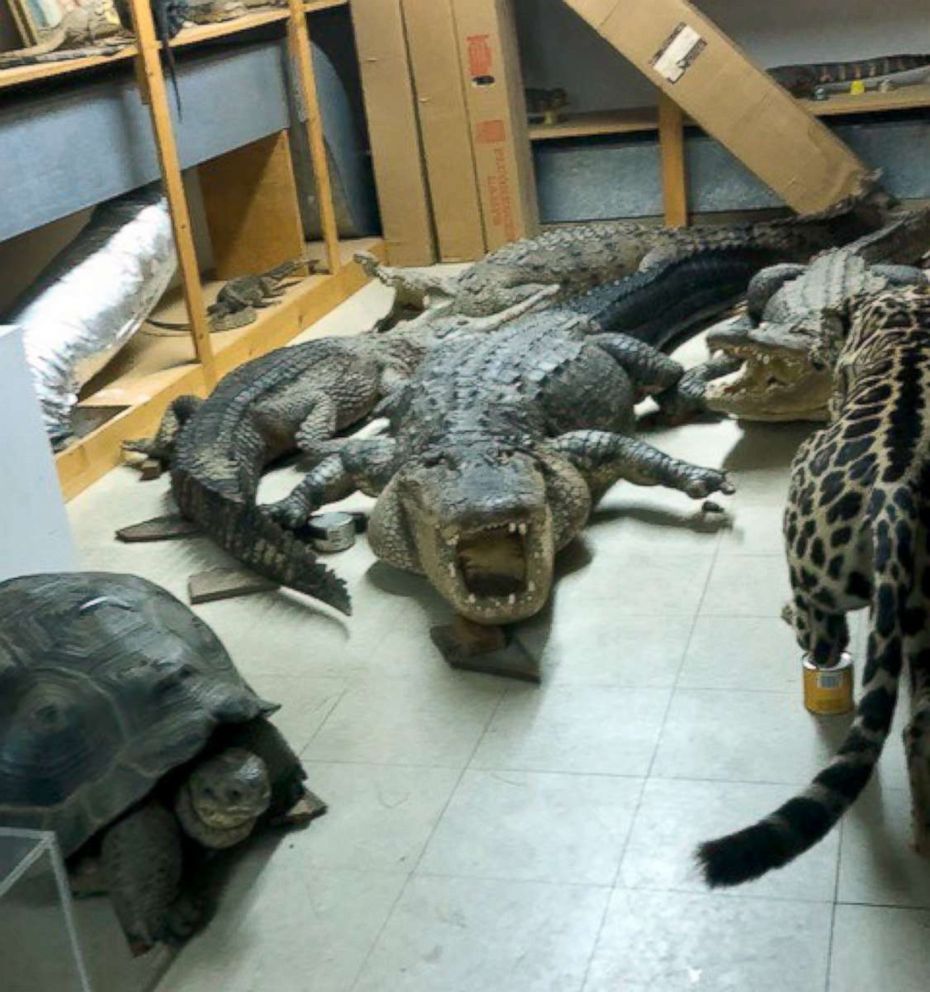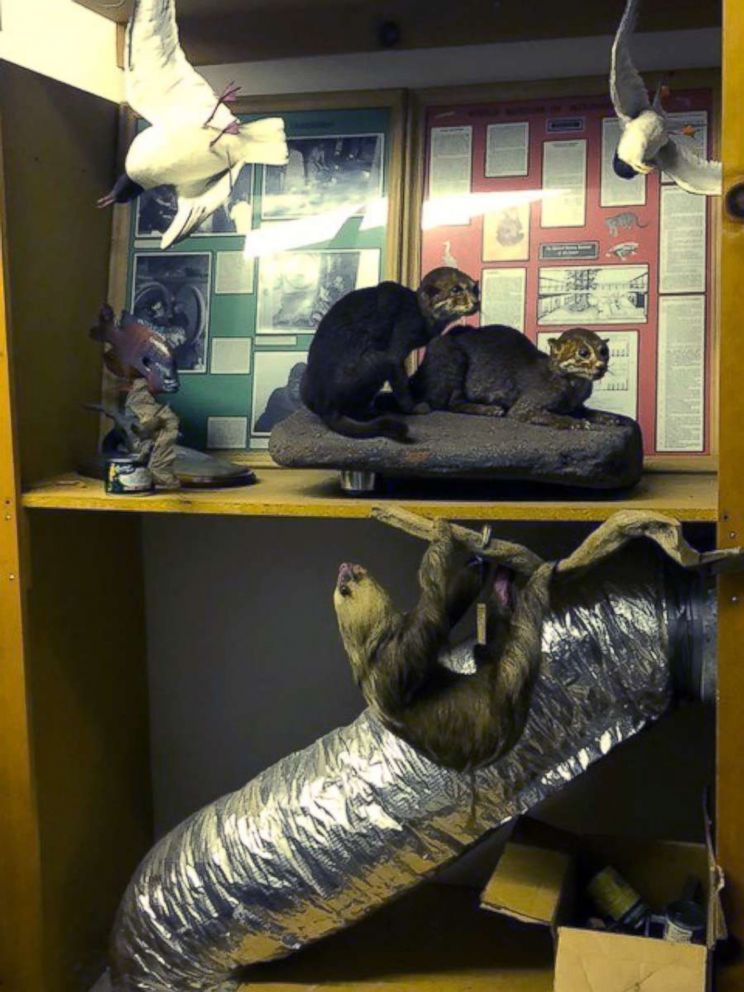Inside one of the world's largest taxidermy collections
A small museum in California contains a remarkable taxidermy collection.
For just three hours a week, a small museum in southern California opens its doors to display one of the world's largest and rarest collections of taxidermy -- a labor of love largely created and curated by one man.
The museum houses many animals and artifacts that are not in any other museum in the country, including the Kitti’s hog-nosed bat, also known as the "bumblebee bat" -- the smallest mammal in the world; a pygmy marmoset, the smallest monkey that exists and one of the smallest primates; and “Minnie,” the largest Komodo dragon on the planet. Minnie was ten feet long and weighed 365 pounds when it was alive and sits in the museum’s entrance. Minnie died in 1933, shortly after being shipped to a zoo in St. Louis.
“This museum has endangered, extinct, and exotic animals that some people have never seen before,” said Dr. E.A. “Billy” Hankins, a lifelong taxidermist and professor of dermatology at the University of California's Los Angeles campus -- and the driving force behind nearby La Sierra University’s World Museum of Natural History.

The World Museum of Natural History ranks high among the top 30 natural history museums in the country by Best College Reviews. It is only open once a week, on Saturdays for 3 hours and is free to all visitors. Hankins serves as the museum’s founder and curator.
Natural history museums are important because they serve as an archive to preserve species that are either endangered, extinct, or rare.
The museum houses hundreds of impeccable displays of exotic and rare reptiles, mammals, birds, insects and amphibians from across the globe.
Hankins, 79, is so renowned in his field that he has contacts all over the world, and when an especially unique animal dies in Asia, Africa or the Americas, Hankins is often the first call.
"Sometimes I go and pick them up, or if they are in zoos that are out of state, they are shipped by air overnight," Hankins said. "In foreign countries, sometimes you have to go there and go through a permit process to bring them back into the country and partially prepare them, they are usually brought frozen back to the museum. There are different ways of getting the specimens.”

He practiced for decades as a dermatologist in the Los Angeles area, and would work on his taxidermy collection sometimes until 3 a.m. -- preserving exotic animals by mounting them over an armature or stuffing them for the purpose of display.
"When I was 5 years old I started making insect collections, and then graduated into doing taxidermy," he said. "When I was 8 or 9 years old, a saw a local taxidermist do a live mount of a hawk. I learned how to do taxidermy when I was in grade school."
To Hankins, his passion for taxidermy serves as a way to record species -- including those that are extinct, threatened, or endangered -- in the form of study skins and life-size mounts. He also uses his work as a way to memorialize animals and to investigate their cause of death.
”Natural history museums are important because they serve as an archive to preserve species that are either endangered, extinct, or rare – in the future, they may actually be gone due to pet trades, food consumption, poaching, and habitat loss,” Hankins said.
As a taxidermist and a dermatologist, he is aided by his natural familiarity with both human and animal anatomy, sculpture, painting and tanning to transform the animals into the most life-like statues.
His experience in his field is unmatched. He has been mounting exotic animals since the age of five, when he mounted a coot found near southern California's Santa Ana River.
When I was 5 years old I started making insect collections, and then graduated into doing taxidermy.
His Native American ancestry and childhood background as a kid growing up in the West –- predominantly in Oklahoma, Mexico and California -- fostered an interest in animals, plants, rocks, and natural phenomena and their inherent value.
At one point in time, he owned a pet mountain lion named “Birdy Boy” that he raised since it was a cub.
During his time as a military physician in Thailand, he began to amass a collection of dozens of deceased, stuffed animals. As a dermatologist through study and a taxidermist through trade, “Billy” became a regular at local markets that sold exotic species -- postmortem –- everything from tigers to elephants to all sorts of exotic birds. Thanks to Billy’s help, the museum opened its doors in the 1970s.
Apart from being the museum’s curator and founder, Dr. Hankins also constructed the largest freeze-dryer out of any museum in the country. He built the freezer through surplus equipment purchased from government agencies to draw out moisture from deceased animals while preserving their skin.
To preserve animals in their best condition, he uses a process called “freeze drying” to gently freeze the specimen and extract water in the form of vapor using a high-pressure vacuum.
Dr. Hankins has three large cold storage units with shelves packed with animals that have been preserved and are waiting to be mounted. Inside is also a lowland gorilla who died of a heart attack at a zoo in Houston, still in process for taxidermy.
His dream is to raise enough funds to move his taxidermy collection to a larger space, possibly a new building on campus so that he has enough room for all the specimens. The taxidermy collection at museums of natural history are important to educate others on animals that are endangered or possibly extinct.
His next project is a lowland gorilla in his freezer, who died of a heart attack at a Houston zoo and is waiting to be mounted.
The museum also houses one of the world’s largest and finest collections of mineral spheres, gems, fluorescent minerals, meteorites, tektites, petrified wood, shells, Native American artifacts, and contemplative stones.
Dr. Anna Chacon is a dermatologist and part of the ABC News Medical Unit.




